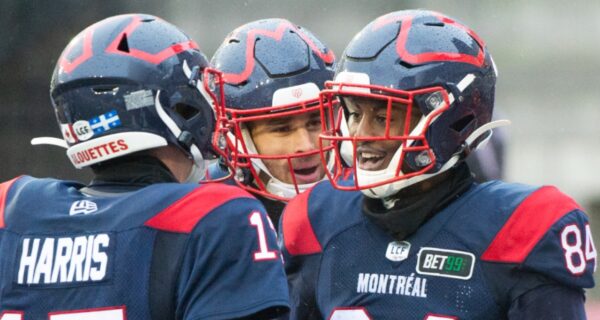A team can score one point in the Canadian Football League by executing a rouge, which occurs when the ball is kicked or punted into the end zone and the receiving team fails to return it out of the end zone. Rouge is a unique scoring method in Canadian football.
The Canadian Football League has various ways to earn points, such as touchdowns, field goals, and conversions.
However, a rouge is awarded when the ball is kicked into the end zone, and the receiving team cannot return it out of the end zone.
This results in one point being awarded to the kicking team. Understanding the rules and scoring methods of the Canadian Football League is essential for players, coaches, and fans alike.
Understanding the Scoring System in the Canadian Football League (CFL)
When it comes to Canadian football, the scoring system in the Canadian Football League (CFL) is unique and may differ from what you’re used to seeing in other football leagues.
To truly grasp the game, it’s essential to have a solid understanding of how points are earned.
In this article, we’ll explore the CFL’s scoring system and provide an overview of the various ways to score points in the game.
The CFL’s Unique Scoring System
The Canadian Football League (CFL) has a scoring system that sets it apart from other football leagues worldwide.
While some elements are similar, such as touchdowns and field goals, the CFL introduces additional scoring methods to keep the game exciting and unpredictable.
Overview of the Different Ways to Score Points
In the CFL, there are several ways to score points on the field. Let’s take a closer look at each of these methods:
- Touchdowns (6 points): A touchdown is one of the most exciting plays in Canadian football. When a player carries the ball into the opponent’s end zone or catches a pass in the end zone, their team is awarded six points. In addition, the scoring team is allowed to try to earn a conversion.
- Conversions (1 or 2 points): After a touchdown is scored, the team can choose to earn additional points through a conversion attempt. In the CFL, there are two types of conversions: the one-point convert and the two-point convert. If the team completes a play from the five-yard line, they are awarded one point. Alternatively, if the team can advance the ball into the end zone again, this time from the ten-yard line, they are awarded two points.
- Field Goals (3 points): Like in other forms of football, a field goal can be a significant way to score points in the CFL. If a team successfully kicks the ball through the opponent’s uprights, they are awarded three points.
- Safeties (2 points): A security is a defensive play that results in the opposing team being tackled in their end zone or committing a penalty in their end zone. When this happens, the team that made the defensive play earns two points, and the opposing team must kick the ball back to them.
- Single Points/Singles (1 point): The CFL is the only football league that gives a team an issue for an unreturned punt or a missed field goal that goes out of bounds through the end zone. When this occurs, the kicking team is awarded a single point, often called a single or rouge.
Understanding the various scoring methods in the Canadian Football League (CFL) will better equip you to enjoy and appreciate the game’s excitement.
Whether it’s touchdowns, conversions, field goals, safeties, or even singles, every point earned can significantly affect the outcome of a CFL game.
How Do You Get One Point in the Canadian Football League?
In the Canadian Football League, kicking the ball through the opposing team’s end zone earns you one point.
The Rouge: An Introduction to the One-point Scoring Mechanism
In the Canadian Football League (CFL), teams can earn one point through a scoring mechanism known as the rouge.
The rouge is a unique feature of Canadian football, differentiating it from other football codes worldwide. This one-point scoring rule adds an extra layer of excitement and strategy to the game.
Rules and Conditions for Earning a Rouge
Unlike in American football, where a touchdown is the primary scoring method, the CFL includes additional scoring opportunities such as the rouge.
To understand how to earn one point through a rouge,
let’s dive into the rules and conditions:
- Field Position: To earn a rouge, the offensive team must kick the ball toward the opposing team’s end zone. The ball must be punted, drop-kicked, or missed field goal attempt.
- Ball Exit: Once the ball is kicked, it must exit the end zone without being returned by the opposing team or touched by the receiving team’s goal-line players.
- Single Point Awarded: The kicking team is awarded one point if the ball successfully exits the end zone without being returned or touched, known as a rouge.
In essence, the rouge allows teams to score a point even if they cannot score a touchdown or kick a field goal.
It rewards teams for strategic kicking and defensive plays, adding an element of surprise and unpredictability to the game.
The rouge can significantly impact the outcome of a CFL game. In close matches, where every point counts, the potential for a single point through a rouge can shift the momentum or lead to tie-breaking scenarios.
It encourages teams to consider their kicking strategies carefully to achieve the elusive one-point advantage.
So, remember the rouge the next time you watch a CFL game and see a team earn a point seemingly out of nowhere.
This unique scoring mechanism showcases Canadian football’s nuances and thrilling aspects, making each game an exhilarating experience for players and fans.
The Role of Special Teams in Scoring One Point
In the Canadian Football League, one point can be earned through special teams. Special teams play a crucial role in scoring that single point.
Exploring the Significance of Special Teams in CFL Scoring
Special teams play a crucial role in earning those precious points in the fast-paced and unpredictable world of Canadian Football League (CFL) scoring.
While touchdowns and field goals often steal the limelight, the unsung heroes of special teams ensure those one-point scores add up.
In this section, we will delve into how special teams make a difference in the CFL, focusing on their strategies and techniques to secure that single but invaluable point.
Highlighting the Strategies and Techniques Used By Special Teams
Special teams are like the secret weapon of any CFL team, comprising players who possess the agility, speed, and insight necessary to execute effective plays.
From well-coordinated punt and kick returns to field position battles, the players on special teams strive to earn those one-point scores in multiple ways.
Let’s break down some of the primary strategies and techniques employed by special teams:
- The Rouge Kick: One of the most unique aspects of CFL scoring, the rouge kick involves the kicker successfully pushing the ball into the opponent’s end zone without the receiving team being able to return it. This play not only earns a point for the kicking team but also forces the opposing team to start from their 35-yard line, giving the kicking team a significant advantage in field position.
- Punt Returns: Special teams players with exceptional speed and agility are responsible for maximizing the yardage gained on punt returns. By eluding the opposing players and finding gaps in the defense, these players can boost their team’s field position. In some instances, a triumphant punt return can even result in a touchdown, but it all starts with gaining those extra yards.
- Kickoff Returns: Like punt returns, kickoff returns play a strategic role in gaining advantageous field position. The special teams players must read the opposition’s kickoff coverage, identify the open lanes, and exploit the gaps to gain valuable yardage. A more extended return can put the offense in a better position to score points, while a shorter return still helps win the field position battle.
- Onside Kicks: In desperate situations, teams may attempt an onside kick to regain possession of the ball. Special teams players execute this technique precisely, aiming to bounce the ball off the ground at a specific angle while adhering to CFL rules. Recovering an onside kick allows the offensive drive to continue and can swing the game’s momentum.
These are just a few examples of the strategies and techniques employed by special teams in the CFL.
Whether through a rouge kick or an electrifying punt return, these players are dedicated to securing that one extra point that can make all the difference in a game.
The significance of special teams cannot be understated, as their efforts contribute to a team’s overall success and shape the outcome of CFL matches.
Examples of One-point Scoring Situations
Scoring a single point in the Canadian Football League (CFL) might seem rare, but there are specific scenarios where a team can earn that coveted one point.
In this section, we will analyze real-game situations where teams have successfully scored one point and examine case studies of rouge plays in different CFL matches.
Analyzing Real-game Scenarios Where a Single Point is Scored
Scoring a single point in the CFL can happen when the defending team fails to bring the ball out of their end zone. This can occur when:
- The receiving team does not return the punt or kickoff and goes out of bounds in the end zone, resulting in a single point for the kicking team.
- A missed field goal attempt goes wide and is not fielded by the defending team in the end zone, allowing the kicking team to score one point.
- The offensive team concedes a safety touch, resulting in a single point for the defending team.
These scenarios demonstrate the importance of strategic play and defensive awareness, as a single point can sometimes make a crucial difference in the outcome of a game.
Strategies for Preventing One-point Scores
In the Canadian Football League (CFL), getting a single point, a rouge can significantly impact the game.
Understanding teams’ strategies to prevent this scoring opportunity is crucial for defensive success.
In this section, we will delve into the defensive techniques employed to avoid rouge points and examine the tactics used by teams to deny their opponents a scoring opportunity.
Defensive Techniques Employed to Prevent Rouge Points
Defending against a rouge point requires a combination of strategic positioning, awareness, and execution.
Here are some defensive techniques utilized in the CFL:
1. Smart Field Positioning
A key aspect of preventing a rogue point is strategically positioning yourself on the field.
By understanding the rules and where opponents typically aim for their kicks, defenders can adjust their formation to minimize any scoring opportunity.
For instance, defenders may shift towards the goal line to increase the distance opponents need to kick the ball for it to go out of bounds and avoid a rouge.
2. Rapid Pressure on the Kicker
Putting pressure on the opposing team’s kicker can disrupt their ability to execute a successful punt or field goal attempt.
Defenders can employ tactics such as a well-coordinated rush, precise timing, and targeted blocking.
By forcing the kicker into a hurried or inaccurate kick, defenders can minimize the likelihood of a rouge point being scored against their team.
Examining Tactics Used By Teams to Deny Their Opponents a Scoring Opportunity
Teams in the CFL employ specific tactics to deny their opponents a scoring opportunity, particularly when preventing a rouge point.
Let us explore some of these strategies:
1. Aggressive Coverage on Kicks
In the CFL, attacking the opponent’s kick by swarming the area where the ball is expected to land is common.
This tactic allows defenders to prevent their opponents from gaining possession or making a triumphant return, reducing the chances of scoring a rouge point.
Defenders aim to force the opposing team into an unfavorable field position by maintaining tight coverage and pressuring the returner.
2. Quick Reaction Time to Field Goal Attempts
Reacting swiftly to field goal attempts is crucial for defensive success in preventing a rouge point. Defenders must anticipate the snap and quickly penetrate the line to block or disrupt the kick.
By effectively timing their jump, defenders can obstruct the ball’s trajectory and prevent it from crossing the goal line, denying their opponents any points.
Final Thoughts
Earning one point in the Canadian Football League requires a strategic approach. Every point counts through a rouge, a missed field goal, or a punt ending in the opponent’s end zone.
By understanding the rules and exploiting the opportunities, teams can maximize their chances of scoring that valuable single point.
So, next time you watch a CFL game, pay attention to those unique scoring methods that can make all the difference.












